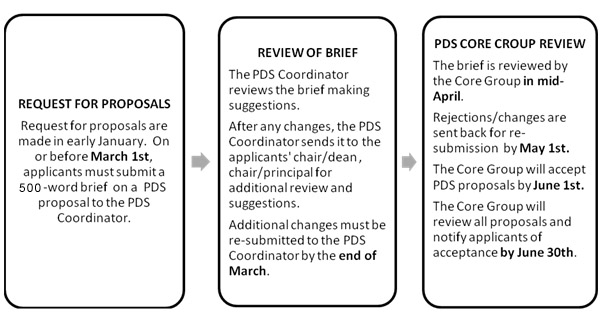
The process for submitting PDS proposals will begin January, 2010 when an official "Request for Proposals" is made. Proposals are expected to involve both college and school district faculty. Before writing a full proposal, a 500-word brief describing the proposed project is required. Include:
- Names of faculty from both institutions who are directly involved with the project and or authors of the PDS project.
- The goal/mission of the project - please refer to the PDS section on the NCATE website for inquiry-based goals (www.ncate.org). Project must focus on:
- teacher development
- preparation of new teachers
- student achievement, improvement of teaching practices to be inquiry-directed
A brief description of the project and how collaboration between the 2 institutions would be conducted:
- Identify a desired outcome relating to the above NCATE goals. Briefly describe a plan of action to attain these outcomes (an example could involve instructing and demonstrating inquiry-based practices to both teachers and teacher candidates who are completing their field placements).
- Include how the college and school faculty, teacher candidates, and students will collaborate and directly benefit, citing any research.
- Describe specific plans for faculty development.
- Include assessment procedures to chart the progress for both faculty development and student achievement. Please note that IRB approval may be necessary from both college and school district.
- Include anticipated duration of the project.
- Estimate how much funding is needed (allowable budget items - books, materials, conferences, teacher stipends/substitute coverage for cooperating teachers. Budget items that are presently not allowed during the academic school year are stipends or release time for professors).
- Please refer to the *PDS Prospectus and Evaluation Criteria on the PDS website, www.cortland.edu/pds. This includes format for PDS proposals, including the criteria used for evaluating the proposal.
Submit a 500 - word brief or abstract proposal no later than March 1st to the PDS Coordinator who will make any suggestions for changes. Resubmit the changes to the PDS Coordinator who will then submit the brief to your chair/principal or chair/dean. Each may list any concerns or recommended changes that must be made by the end of March. Resubmit the brief to the PDS Coordinator who will present it to the Core Group for review in mid-April. Notification of acceptance of briefs will be in mid-April; any changes must be made by May 1st. Written PDS proposals are due within one month of the brief's acceptance, no later than June 1st.
The Core Group will announce proposal approval by June 30th .
VI. Format for PDS Proposal:
- Title
- Include names of authors and planners with their. Both school district and college collaborators should be listed.
- State the mission and vision of the project in concrete measureable terms.This response might include a paragraph or two of mission statement followed by a list of measurable goals for the program. When identifying program-specific goals consider the general NCATE/ PDS goals of:
- improved student learning
- inquiry directed improvement of practices
- professional development for teachers and faculty
- enhanced preparation of teacher candidates
- In no more than one wordprocessed page, describe the essentials of the program in a brief description.
- How will this program strengthen the partnership between CECSD and SUNY Cortland?
- How will this program improve student learning and have a positive impact? What assessments will be used to track improvements?
- How will this program improve teacher candidate preparation in their pedagogy classes and/or field placements? How will this be measured?
- How will this program expand and improve the skills of district teachers? How will this be measured?
- What research opportunities will this program create? Identify at least one research project that will emerge from this project and state how this research will be publically presented.
- What resources and personnel will be required to implement this program?Be specific. Where will the program be carried out (building, facilities,rooms)? When will it take place (day and times)? What, if any, special equipment will be needed? Who will be responsible for each program element?
- Identify a "common ground" of pertinent literature and practices to be explicitly taught to teachers and teacher candidates. Prepare a bibliography that documents support for the proposed interventions in the relevant literature.
- Prepare a budget for implementation of this program. The budget should address each of the following (if relevant to your project):
- personnel costs (salaries, stipends, etc.) Please note that stipends and release time for college faculty during the academic year are discouraged
- materials and equipment
- conference, travel, presentation costs
- How will this program be evaluated? What measurable outcomes that address the mission (goals) identified previously will show the program has been successful? Develop an evaluation plan that specifies how the program success will be determined. In addition to this summative assessment scheme, each evaluation plan should include formative assessments that will allow refinement of program in process.
- Briefly describe a plan to pursue external funding to continue/expand the project. Identify at least one possible grant source to support this project.
VII. Criteria for Evaluation of Professional Development School Proposals
IMPORTANT To view the criteria that the Core Group uses to evaluate PDS proposals go to the website: www.cortland.edu/pds. Click on "Cortland Enlarged School District PDS", and then click on "PDS Evaluation Criteria for 2010 Proposals".
VIII. Guidelines on Resources
- Although both institutions are committed to supporting the PDS, specific monetary contributions to the project have not been finalized. Planners should attempt to develop realistic, but resource modest proposals.
- Monetary resources will be considered for supplies, materials, personnel, professional development, and other expenses for clearly supported proposed program activities.
- Every effort should be made to utilize resources that already exist within either institution. Making use of existing inkind resources might include but not be limited to space utilization, materials already used for current programs, redeployment of faculty, classroom placements, inkind services, vehicle use, laboratory facilities, and course vouchers.